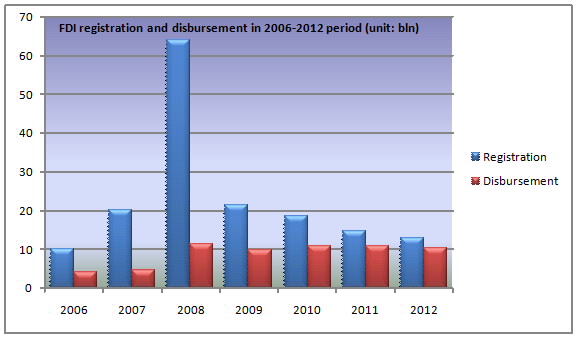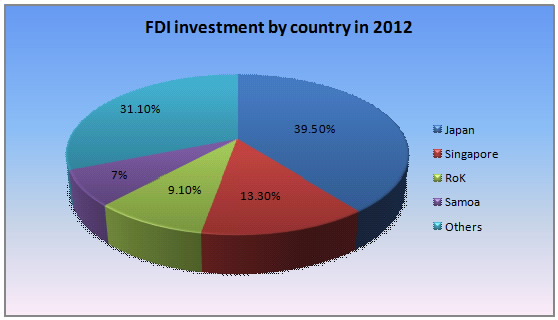Investment climate still charms foreign players
VGP – Viet Nam still remains a magnet for foreign investors despite shrinking inflows of foreign direct investment (FDI) it faced during hard economic time.
 |
|
Source: VGP |
Sliding FDI registration
In 2009, inward FDI in Viet Nam started to tumble to around two thirds against 2008 and has then dropped constantly to about US$10 billion, which was mostly blamed for the global economic downturn.
The situation saw slow improvements when there were fewer invisible projects and large-scale real estate projects and the country initiated a new policy on practical FDI projects, according to Dr. Tran Du, Chairman of the Viet Nam Association of Foreign Invested Enterprises (VAFIE).
In 2011, the country’s inflation rate at 19.58%, which was recorded the highest in Asia, strongly eroded confidence of international businesses. Foreign investors became apathetic to strengthen their footholds in the market as they felt punchy pulses of price hikes, especially on salaries and production materials, as well as interest rates.
While FDI capital flow into Viet Nam faced a decline, FDI disbursements remained stable and practical at around US$10 billion over the last four years.
In addition, FDI capital structure has been converted in some fields, with the inflow in the industrial and construction sector slipping from 85% to only 22% while that in the services sector made an upward move, advancing from 7% to 77%.
Promising signs

In 2012, Viet Nam was rated as the second largest FDI recipient in Southeast Asia after Singapore thanks to its cheapest labor cost and more competitive business environment, according to the latest report of the Hong Kong and Shanghai Bank (HSBC).
The bank forecast that Viet Nam is still a dynamic economy which specializes in low-skilled manufacturing industries like garments, textiles and footwear.
A recent ASEAN Business Council survey ranked Viet Nam as second most attractive investment destination behind Indonesia and ahead of Singapore, Thailand, and Malaysia. Indeed, in comparison with the neighboring countries, Viet Nam still has advantages of cheap-labor costs, political stability and good geographical positioning.
Experts predicted that the closer diplomatic ties between Viet Nam and other countries like Japan, the US and Russia would open up more opportunities for FDI inflows.
Particularly, economists also proposed Viet Nam take a proactive role in improving the local investment environment to greet a new wave of Japanese investment in the country.
Amid hard economic period, a number of foreign investors still select Viet Nam as a favorable destination.
Lately, Starbucks, the largest coffeehouse company announced that it would open its first cafe in Viet Nam early next month in Ho Chi Minh City.
The Seattle-based company hoped to exploit the market with over 60% population that was born after war and there is a strong demand among youth in Ha Noi and Ho Chi Minh City for branded clothing and accessories.
U.S.-based KKR recently also agreed to invest US$200 million in Vietnamese sauce maker Masan Consumer Corp., marking the largest investment to date in Viet Nam by a private-equity firm.
Earlier, Italian motorbike-maker Piaggio in March 2012 opened a new engine manufacturing in Viet Nam to expand production of its wind turbine factory.
Government actions
The Vietnamese Government has deployed a series of steps to uphold the role of private investment and FDI and reduce state investment in the economy.
A project on orientations to raise the efficiency of foreign direct investment (FDI) attraction, use, and management till 2020 was put on the table for discussion.
The project aims to resolve shortcomings and weaknesses in the attraction and management work and improve the investment environment towards higher competitiveness especially in a time when the country is undertaking the economic restructuring and growth model renovation./.
By Huong Giang

